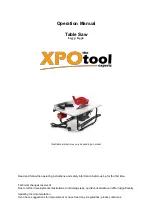
Safety instructions for saws with pendulum guard and saws with tow guard
Lower guard function
a)
Check the lower guard for proper closing before each use. Do not operate
the saw if the lower guard does not move freely and close instantly. Never
clamp or tie the lower guard into the open position.
If the saw is accidentally
dropped, the lower guard
may be bent. Raise the lower guard with the retracting
handle and make sure it moves
freely and does not touch the blade or any other
part, in all angles and depths of cut.
NOTE Alternate wording for "retracting handle" is possible.
b)
Check the operation of the lower guard spring. If the guard and the spring
are not operating properly, they must be serviced before use.
Lower guard may
operate
sluggishly due to damaged parts, gummy deposits, or a build-up of debris.
c)
The lower guard may be retracted manually only for special cuts such as
"plunge cuts" and "compound cuts". Raise the lower guard by the retracting
handle and as soon as the blade enters the material, the lower guard must be
released.
For all other
sawing, the lower guard should operate automatically.
NOTE Alternate wording for "retracting handle" is possible.
d)
Always observe that the lower guard is covering the blade before placing
the saw down on bench or floor.
An unprotected, coasting blade will cause the
saw to walk
backwards, cutting whatever is in its path. Be aware of the time it takes
for the blade to
stop after switch is released.
Warning: Keep hands away from the cutting area and blade. NEVER place your hands
behind the saw blade since kickback could cause the saw to jump backwards over
your hand. Keep your body positioned to either side of the saw blade.
1.
Check the lower guard for proper closing before each use. If the saw is accidentally
dropped, the lower guard may be bent. Raise the lower guard with the lower guard lever
and make sure it can move freely and does not touch the blade or any other parts in all
angles and depths of cutting. Do not operate the saw if the lower guard does not move
and close freely. Never clamp or tie the lower guard into the open position.
2.
Adjust the cutting depth to the thickness of the workpiece. Less than a full tooth of the
blade teeth should be visible below the workpiece.
07






































